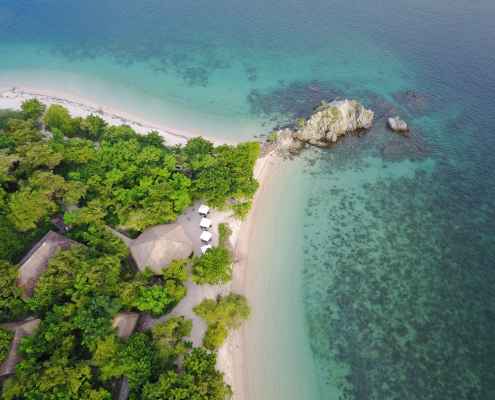Villa Sands
Angel Island is a small eco resort set on a stunning island just off the west coast of Flores in Eastern Indonesia. Built with clear conservation goals in mind, this resort has combined a passion for being as close to nature as possible while maintaining quality and service. Situated on the 15 hectare island of Bidadari (meaning ‘angel’ in Indonesian), there are 10 private villas set in a lush hibiscus garden. Surrounded by a flourishing coral reef, Angel Island is the only protected island in the area, allowing it to be a haven for wildlife, both in the water and on land.
Meals are served throughout the day in the beach front restaurant with inspiring views of Flores and the surrounding archipelago. The full ala carte Western, Asian and Vegetarian menu is 100% organic and freshly sourced from local suppliers and sustainable fishing practices.
There are 3 deluxe spacious cottages and 7 regular cottages at Angel Island. These hand-crafted cottages are spaced out among exotic tropical gardens giving an amazing sense of privacy in nature. Constructed from the finest materials, the cottages provide all modern facilities, including air conditioning, hot water, free WiFi, private open air bathrooms, Pod style French Espresso coffee machine, flat screen TVs with a selection of films, mini bar and safety box.
Deluxe Cottages
Spacious AC Cottages set in our gardens of Hibiscus, less than one minute to the beach. Private bathroom in Walled garden with Hot water shower. An Extra bed can be added to each Deluxe Cottage max 3 people per room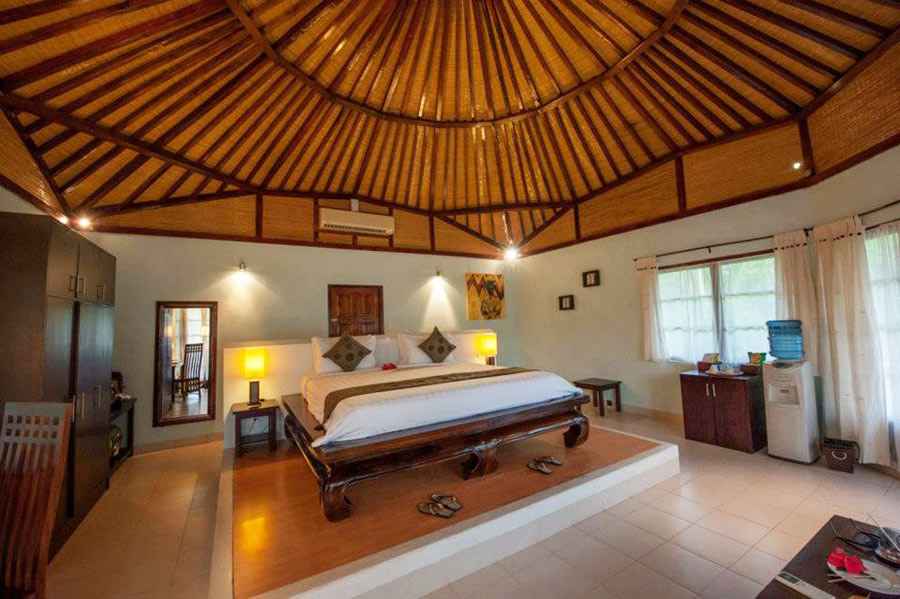
Regular Cottages
Cottages are a smaller that the deluxe cottages which can only be a Double or Single. The cottage has the same facilities as our Deluxe cottages but are smaller and have a Garden bathroom with fresh water hot shower.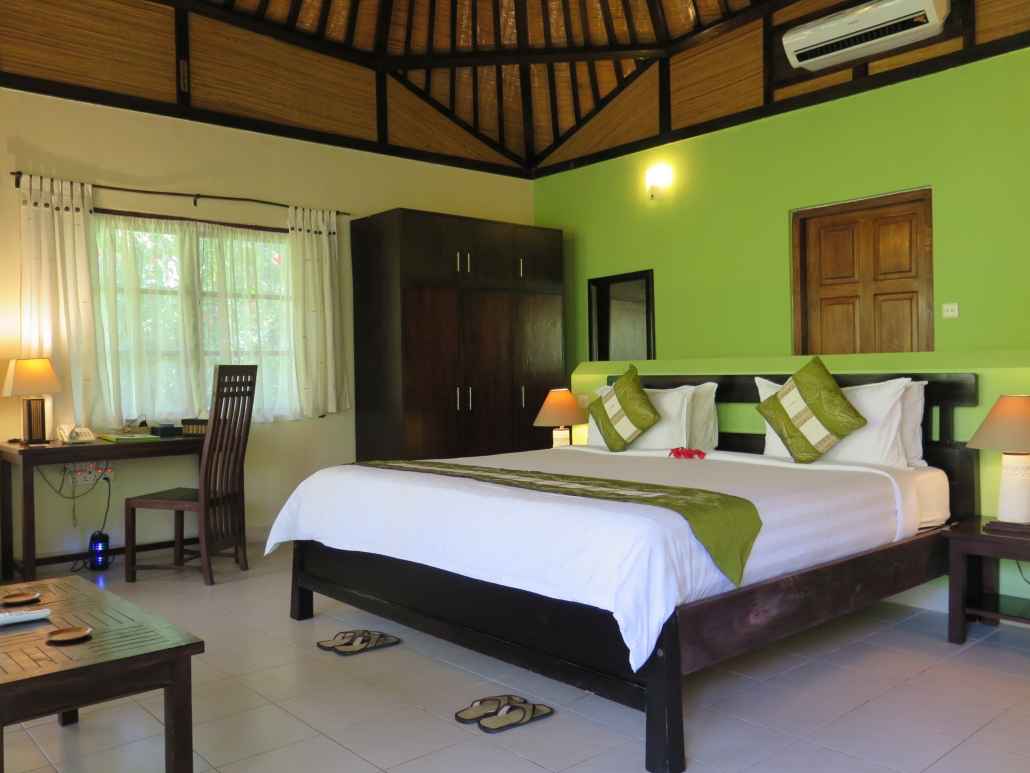
Dive the best sites in Komodo National Park with Angel Island Resort. They make daily dive trips into Komodo National Park with their traditional boats. They dive here all year around, so the Instructors truly know the sites, currents and critters. Divers leave Angel Island 8.00 am and return around 2:00pm depending on which sites visited, it takes between 60-90 mins to reach the sites in the National Park.
Dive Sites
There’s easy access to the North and Central areas of the park. As conditions in Komodo can vary dramatically, you’ll only dive sites when the conditions are right for the divers on the boat. Some of the sites visited are:
North Komodo – Gili lawa Laut Area
Crystal Rock
Marked by rocks which just break the surface at high tide, a wonderful dive site with lots of coral of all varieties, a dive to see big and small marine life, white tip reef sharks, Giant trevallys with schools of fusiliers, hawksbill turtles and often an eagle ray can be spotted gliding in the current, a good place to spot many nudibranchs, scorpion fish and octopus, sometimes we get a quick glimpse of dolphins swimming in the current and checking us out.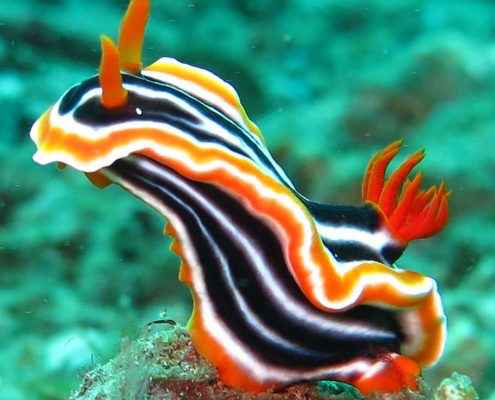
Full Moon
Further north is a submerged sea mound. This site is covered in many varieties of hard corals, heading down, bat fish will come to greet you and try to swim between your fins and catch your bubbles as you exhale, you find Hawksbill turtles and processions of bright luminous blue fusiliers, it’s not a surprise to see white and Black tip sharks checking out the action for their next meal, a couple of big grey sharks hang out deep on this site and sometimes come into the shallower depths, dolphins again have been seen here, good place to see blue ribbon eels and Crocodile fish.
Lighthouse Reef
A couple of Huge Napoleon wrasse make their home here, designated as a Coral Trout aggregation area there are certainly some huge specimens patrolling the waters, a huge underwater rock is the entry point of the dive going down to the depths, we swim along the wall and gradually make our way up into the shallows with groups of red tooth triggerfish and Palette Surgeons, often Mantas come into the shallows to be cleaned, you find a comfortable spot, then wait for the procession to begin.
The Cauldron
As the name might suggest to you, it is really something to see when the current is running, it looks like the top of a boiling pot, once the current abates, we drop down into the centre of the cauldron onto a sandy bottom at 24mts the edges of the cauldron are rock faces with huge ledges gouged into them covered in every colour of hard and soft corals you can imagine, Black and White tip sharks play here, with huge giant, big eye and blue fin trevallys stalking us and glaring at us with their grumpy faces.
Stingray City
Again the name suggests lots of blue spotted mask rays and blue spotted fan tail rays, a big group of bumphead parrot fish live here and 2 giant frog fish, off the steeper slopes we often see white tip reef sharks, lots of anemones with their colourful clown fish, sometimes Mantas feeding in the shallow water.
Coral Garden
Steep wall turning into a slope of coral then up to a sandy ledge with big coral heads leading up to a wonderful coral garden in the shallows, we often see white tips sleeping in the sand with many varieties of rays including jenkins whip rays, porcupine rays, blue spotted and of course everyones favourite the Manta. Good place to find crocodile fish and leaf scorpion fish.
Aquarium
A ledge at 5 mts shelters us from the current we stay a while and watch the fusiliers feed, we’ve often had manta moments here with them staying most of the dive and feeding in the current then swooping in to take a look at you, we spent one dive in the same place here for 105 mins, never moved and only went up as we were running low on air; but if it’s quiet, we swim over into the current and take a ride to end up in a sandy plateau at about 12mts and spend the dive searching the coral heads for leaf fish and critters of every variety, white tips sleep in the sand with the smaller ones hiding under table corals, bumphead parrot fish always seen here, hawksbill turtles, pipe fish and garden eels popping up from the sand like a field of wheat.
Gold Passage
A drift dive starting in the shelter of the bay with slope leading to a steep wall, then moving along to catch the current which sweeps us along at some rate of knots passing giant trevallys, bumphead parrot fish, schools of fusilers to end up on a sheltered coral slope to look for the crocodile fish, leaf fish and any other little critters that catch our eye.
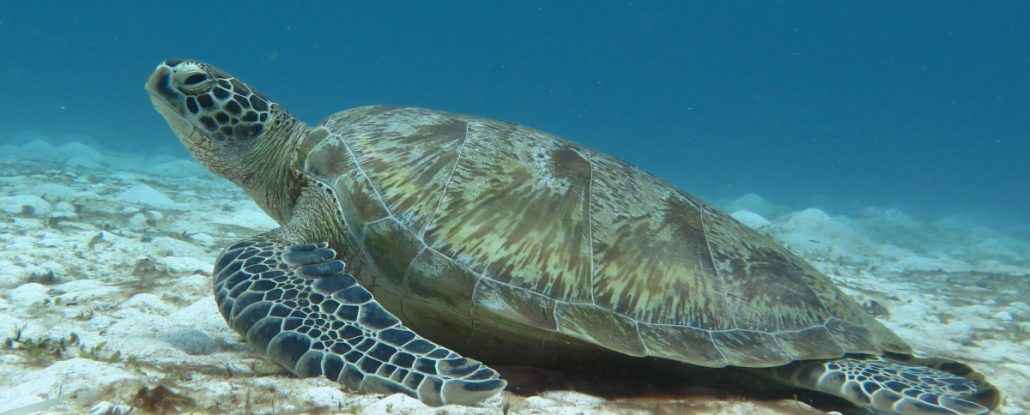
East of Komodo Island
Sebayur kecil
Walls and slopes of every kind of coral you can imagine, with a wide variety of marine life to be seen at this site, a great place for macro photography with leaf scorpion, Ornate ghost pipe fish, robust pipe fish, banded pipe fish, blue ringed octopus, crocodile fish to name a few.
Tetawa Besar
Orange Grove a gentle slope runs the length of this dive site with an orange soft coral garden changing to hard coral along towards the end of the slope, lots of schooling fusiliers, usual to see a lot of Hawksbill turtles and white tip reef sharks, lots of Mantas in the rainy season and a huge variety of beautiful coloured nudibranchs.
Manta Corner another nice coral covered slope with the hope of spotting mantas in the rainy season, nice coral with leaf scorpion fish, blue ribbon eels, turtles, white tips and lots of nice coral heads in the shallow to check out the smaller critters.
Tetawa Kecil
a small island that is in an area that gets a lot of current in Komodo so not an easy site, but it’s another that is among one of the many world class sites here, schools of pelagic fish patrol the waters, a huge school of bat fish live here near a coral encrusted overhang, Napoleon wrasse, bumphead parrot fish with nurse sharks and bamboo sharks found hiding in cracks and crevices in the coral encrusted boulders, the shallows again are a vibrant colourful picture of hard corals that hide the sea snakes, coral file fish and baby sharks.
Batu Bolong
A small rock outcrop with a hole through it is the surface mark of another world class site, these giant slabs of rock which disappear into the depths are an amazing sight to see, covered with every form of marine life and patrolled by giant trevally, Napoleon Wrasse, sharks and turtles with many pelagics sweeping in to check out the divers.
Siaba Kecil
Beautiful coral slope with currents along the edges which bring in the bigger fish, lots of life, water is sometimes chilly here, black tips, white tips, barracudas and a host of nudibranchs and flat worms.
Airstrip
The strangest dive site in the park! a very long stone rubble road stretching forever along the East coast of Komodo, it gently slopes off and has big coral heads at intervals along the road, we tuck in behind these to hide from the current and to check out the marine life there, then take off in the current again, often seeing manta rays, white and black tip sharks, nurse sharks and bamboo sharks under coral ledges and one sighting of a leopard shark, dugongs have also been seen here, it is a manta cleaning and feeding station, bumphead parrot fish like the area and many strange nudibranchs can be found.
Penga
Dead mans island. Stunning coral covers the reefs of this small island, sea snakes, turtles, frog fish, Leaf fish, nudibranchs, long nose hawk fish, octopus sometimes Eagle rays and a wide variety of the usual reef fish.
Wainilu
Critter hunt special at this sandy slope, frog fish, seahorses, juvenile Zebra bat fish, mandarin fish, picture dragonets, ghost pipe fish, ribbon eels, zebra crabs, fire urchins, you never know what will pop up!
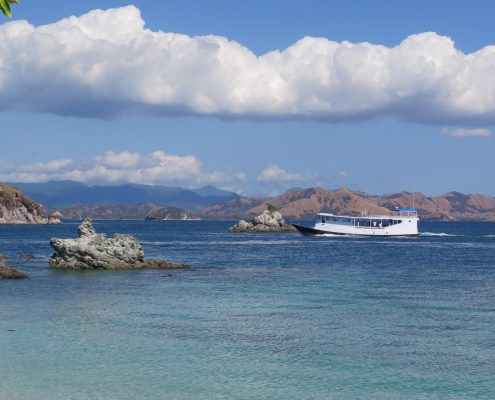
Komodo Dragon Boat Trips
The Komodo Dragons (Varanus komodoensis) Found on Komodo and Rinca Island. You really feel like you are stepping back into a lost world that time has forgotten when you first encounter a Komodo Dragon, these huge monsters belong to the Protected Species Varanus Komodoensis and are the largest lizards in the world, they are meat eaters, although you can be tricked into thinking that these animals are harmless by the way they lazily lounge in the mid day sun renewing their energy, once they start moving they can run faster than a dog over a short distance and one swipe of their tail breaks Deer and Water Buffalo legs, or a bite from them leaves the victim full of deadly bacteria that spreads throughout the body, after a few days they will collapse and are instantly jumped upon by the stalking dragon (not a very pleasant way to go). Dragon Boat trips to Rinca can be easily arranged in the Resort. You can not come to Komodo and not visit the Dragons, only existing on Rinca and Komodo and they think along the Southwest coast of Flores.
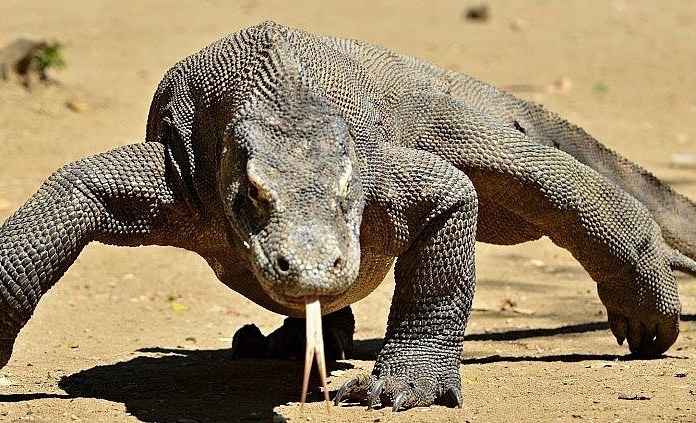
Snorkeling
At Angel Island, a beautiful house reef awaits you just a minute from your cottage front door. This is a typical day of events we often hear from guests: “We enjoyed a leisurely breakfast at the restaurant looking to the sea, and it was so funny we saw fish flying and bubbling at the surface we think from the marine live having breakfast also in front of us, after breakfast we walked down the beach to select a shady sun lounger and we couldn’t believe we saw baby sharks swimming so close to the beach! Are these normal? After about an hour of relaxing we decided it was time to cool off for a while in the water, we received snorkeling gear from the resort staff, 3 hours later we were still snorkeling! We couldn’t believe the amount, variety, and colours of the fish and corals we saw! So many nemos! Stingrays, butterfly fish, angel fish, snappers, big moray eels, and so much more!” (guests even catch sight of turtles and bumphead parrotfish cruising by!).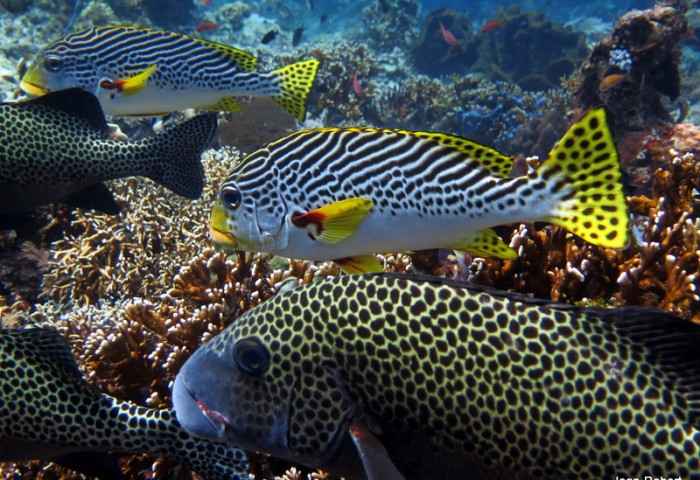
Kayaking
Kayaks are also available free of charge, a perfect way to explore the island’s coastline and surroundings, giving a different perspective to the area.
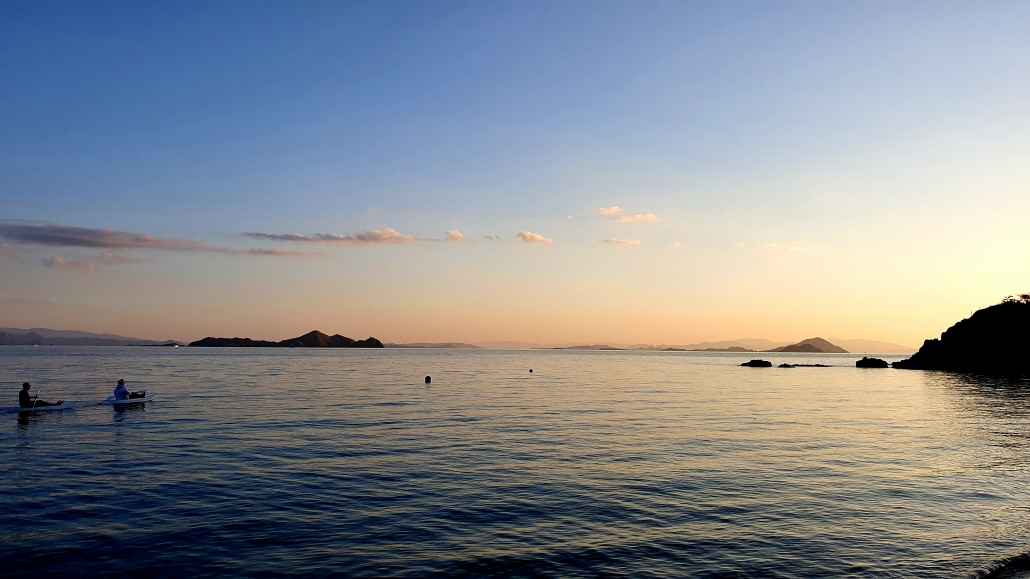
Spa
Angel Island Resort is proud to support the local community by employing visually impaired masseur specially trained in Flores. Relaxing 30 or 60 minute private massages with options for reflexology are firm favourites to unwind after a day of diving or visiting the dragons.
Birding
A stunning array of bird species can be found at the resort and its nearby surroundings.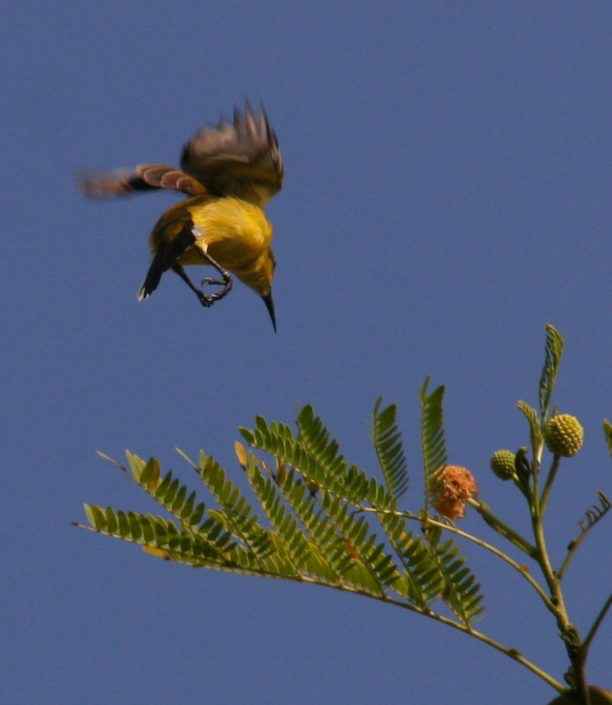
The Vision
The vision has been to create an environmentally friendly resort, providing the ultimate setting for divers, snorkelers and those who want to relax and enjoy the amazing surroundings. We have aimed not for impersonal 5 star service, but rather a friendly atmosphere that is attentive while giving you space to relax and enjoy the attractions of the island. We wanted to create a resort whereby guests staying will benefit the environment, but also the local community.
Core to the ethos used to create Angel Island are some of the following ideas:
To cause as little negative impact to the island, and protect the surrounding beaches and reef.
This has led to villas being set back from the beaches to preserve the natural beach ecosystem, pre-existing clearings have been used for buildings, local government licenses have been secured to gain ‘taman laut’ (sea garden) protection status for the surrounding waters which forbids fishing and protects the coral reef and stopping the taking of white sand from the beaches.
To employ staff only from the local area
This enables workers to be able to stay in the area rather than leave in search for work; also it allows locals to return to their families if they have been working in other areas of Indonesia. Construction and ongoing maintenance on the island has all been conducted by local businesses, using a local work force to help the economy.
Better inform our divers and snorkelers of safe and responsible practices
On every dive trip a marine life briefing is given to help appreciate the underwater world, destructive habits are proactively discouraged, manipulating marine life or environment will be challenged.
Preserve natural resources on the island
No trees were cut down in the building of the resort (villas were built in between trees), as many endemic saplings as possible have been planted; native flora has been planted to encourage the healthy habitat for birds, butterflies and insects. The natural water table has been preserved with water being sourced from a desalination plant.
Grey water from bathrooms is fed into a reed bed system to filter toxins from the water before returning to the environment.